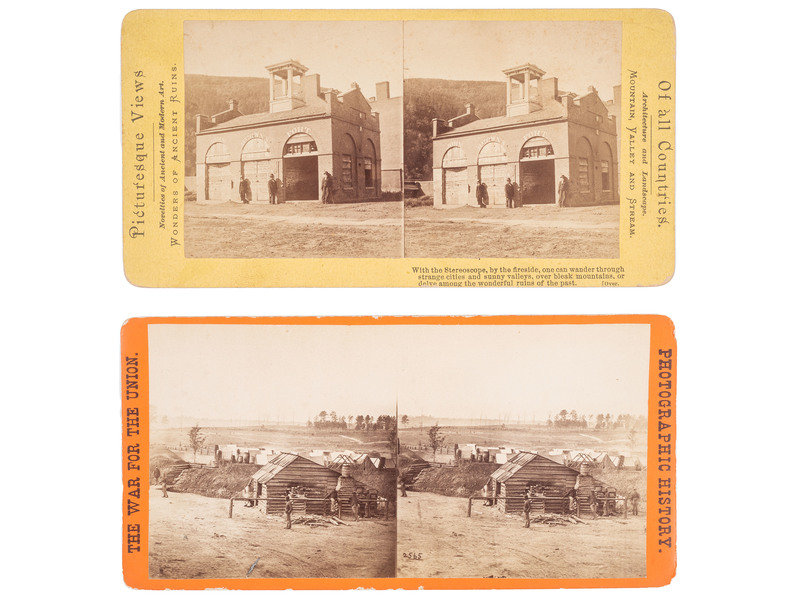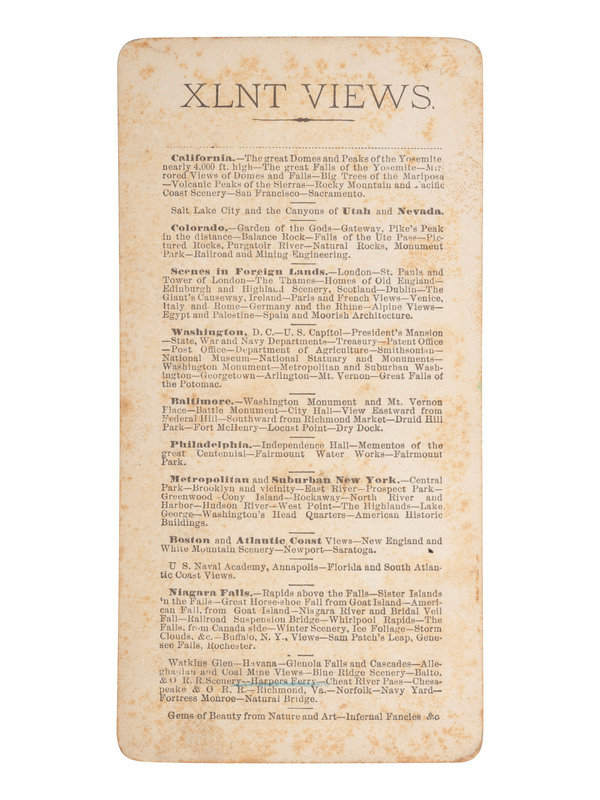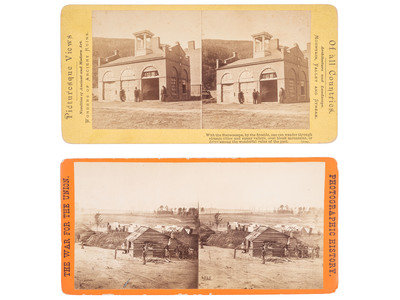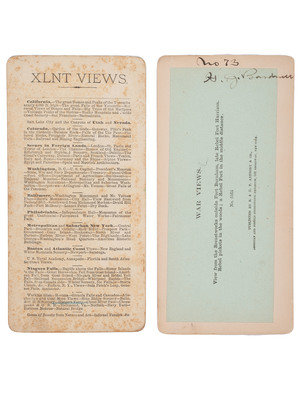[SLAVERY & ABOLITION] -- [BROWN, John]. Stereoview of John Brown's Fort at Harpers Ferry, Virginia. N.p., ca 1870s. [With:] BRADY, Mathew, photographer. Stereoview of African American soldiers of the 7th USCT outside Fort Burnham.
Sale 1118 - African Americana
Feb 28, 2023
10:00AM ET
Live / Cincinnati
Own a similar item?
Estimate
$250 -
350
Price Realized
$315
Sold prices are inclusive of Buyer’s Premium
Lot Description
[SLAVERY & ABOLITION] -- [BROWN, John]. Stereoview of John Brown's Fort at Harpers Ferry, Virginia. N.p., ca 1870s. [With:] BRADY, Mathew, photographer. Stereoview of African American soldiers of the 7th USCT outside Fort Burnham.
5 7/16 x 2 15/16 in. stereoview on cardstock mount (light toningand minor spotting throughout, light soil and wear to mount edges and corners). Series information and title, "Picturesque Views of All Countries," printed on mount recto, listing of "XLNT Views" detailing other series subjects printed on verso.
Featured are three men standing outside of the one-story brick guardhouse with words "John Brown's Fort" painted over arched doorways. The building became famous as John Brown's refuge during his 1859 raid on Harpers Ferry.
[With:] BRADY, Mathew, photographer. Stereoview of African American soldiers of the 7th USCT outside Fort Burnham (formerly CSA Fort Harrison), near Richmond, VA. New York: E. & H.T. Anthony, n.d. 6 1/4 x 3 1/2 in. stereoview on cardstock mount (light edge wear to mount). Mount recto with series title, "The War for the Union." Verso with publisher's imprint and applied paper label with printed caption, "View from the Breastworks outside Fort Burnham, late Rebel Fort Harrison. Rebel pickets in the woods; a Rebel Fort in the middle distance." Provenance: Sergeant Henry J. Bardwell, 27th Massachusetts Infantry (signed and numbered on verso).
Several African American soldiers of the 7th US Colored Troops are shown standing around a cabin, with tents from a forward field camp lining fortified breastworks in the distance. Union soldiers can be seen in dugout positions near the camp, watching for Confederate activity in the distance.
Fort Harrison, later renamed Fort Burnham, was an important component of the Confederate defenses of Richmond during the Civil War. Named after Lieutenant William Harrison, a Confederate engineer, it was the largest in a series of fortifications that extended from New Market Road to the James River that also included Forts Brady, Hoke, Johnson, Gregg, and Gilmer. These earthworks were designed to protect the strategically important Chaffin's Bluff on the James. On 29 September 1864, 2,500 Union soldiers from Major General Benjamin Butler's Army of the James overran Major Richard Cornelius Taylor's 200-man Confederate garrison and captured the fort in the Battle of Chaffin's Farm. Brigadier General Hiram Burnham, a native of Maine and a brigade commander in the XVIII Corps, was killed in the assault, and the Union-held fort was renamed Fort Burnham in his honor. Although the attacks of 29 September had succeeded in capturing only Fort Harrison, General Robert E. Lee saw the potential threat to Richmond and ordered a counterattack on 30 September. The attack failed, but Brigadier General George J. Standard lost an arm while resisting Lee's assault. This failure forced the Confederates to realign their defenses farther west. Fort Burnham remained in Union hands until the end of the war.
Sergeant Henry J. Bardwell worked as a carpenter in Amherst, MA before enlisting as a private on 7 September 1861. Nearly two weeks later, he was mustered into Company "D" of the 27th Massachusetts Infantry, in which capacity he joined Burnside's North Carolina Expedition of 1862 (serving aboard the US Steamer Pilot Boy off Hatteras in February) and performed signal duty at the Battle of Fredericksburg that December. The following year, Bardwell was officially transferred to the US Army Signal Corps in August, and participated in the siege of Knoxville in November. After the war, he was a member of multiple GAR posts in Massachusetts and held office as a post commander in Boston before dying in June of 1923.
Condition Report
Auction Specialist







